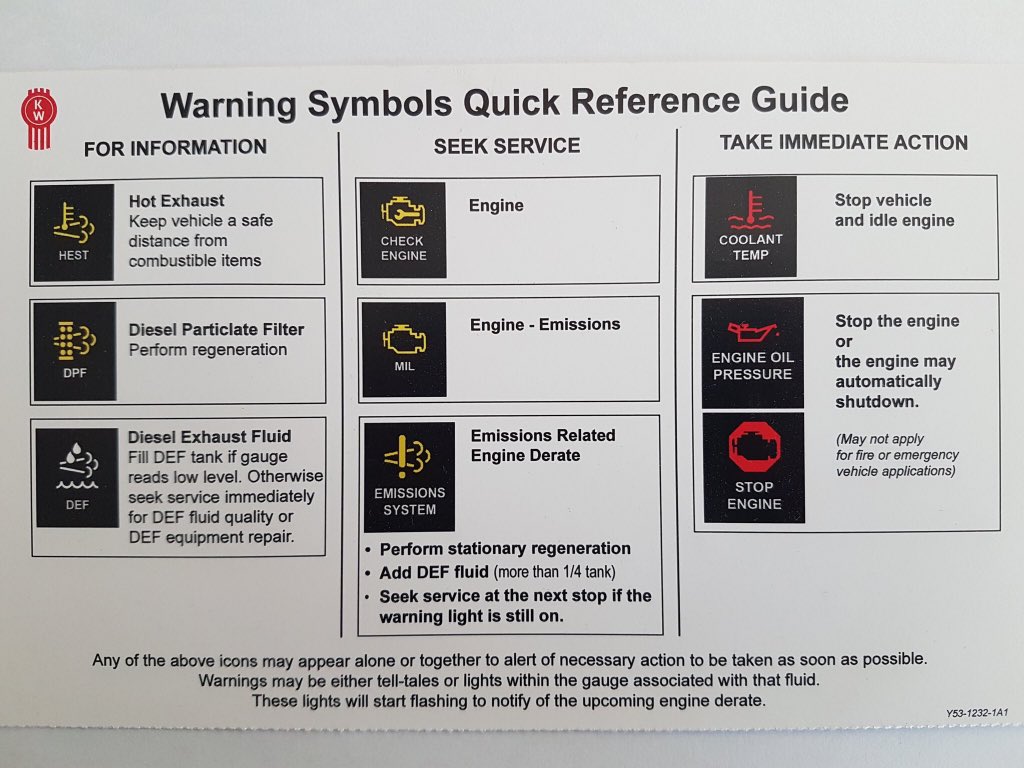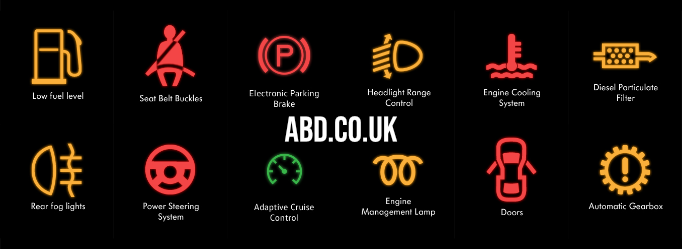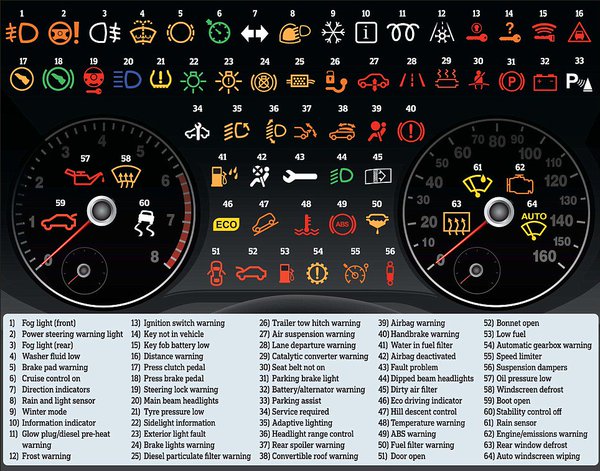Navigating the dashboard symbols in your car is crucial for safe driving. Understanding these symbols and their meanings can help you stay informed about your vehicle’s condition and identify any potential issues.
Whether it’s a warning light for low tire pressure, engine trouble, or a faulty airbag system, knowing what each symbol represents is essential for maintaining your car’s performance and safety. In this quick guide, we will explore the most common dashboard symbols and their meanings, providing you with a comprehensive understanding of your vehicle’s indicators.
It’s important to familiarize yourself with these symbols to ensure that you can address any possible problems and keep your car running smoothly on the road.

Credit: twitter.com
Common Dashboard Symbols
Understanding the symbols displayed on your car’s dashboard is crucial for maintaining its optimal performance. These symbols serve as indicators, warning lights, or information display icons that convey important messages about your vehicle’s systems and functions. In this quick guide, we’ll discuss the common dashboard symbols you may come across while driving. Familiarizing yourself with these symbols will empower you to take prompt action and ensure your safety on the road.
Indicator Lights
Indicator lights provide information about the status of various systems in your car. These lights typically come on temporarily when you turn on the ignition, signaling that a particular system is functional. Here are some common indicator lights you may encounter:
- Engine Temperature: If this light illuminates, it indicates that your engine is overheating. Stop the car immediately and allow the engine to cool down.
- Battery: This light indicates an issue with your car’s battery or charging system. Check the battery connections, alternator belt, or have your battery tested by a professional.
- Oil Pressure: If this light turns on, it suggests low oil pressure. Insufficient oil pressure can lead to engine damage, so pull over, check your oil level, and consult a mechanic if necessary.
- Seat Belt: This light reminds you to fasten your seat belt for safety reasons. Make sure everyone in the car is buckled up before driving.
Warning Lights
Warning lights indicate a potential problem or malfunction in your vehicle that requires immediate attention. Ignoring these lights could lead to serious damage or even accidents. Here are a few essential warning lights:
- Check Engine: The check engine light is perhaps the most common and ambiguous warning light. It can signify a wide range of issues, from a loose gas cap to a faulty sensor. When this light appears, it’s advisable to visit a mechanic for diagnostic testing.
- Brake System: If the brake system light turns on, it could indicate low brake fluid levels or a problem with the braking system. Arrange for an inspection as soon as possible to ensure your brakes are functioning correctly.
- Tire Pressure: This light illuminates when one or more of your vehicle’s tires have low pressure. Check your tire pressures and inflate them to the recommended levels to avoid blowouts or decreased fuel efficiency.
Information Display Icons
Information display icons provide you with additional information about various vehicle features and settings. These icons can be found in newer car models equipped with advanced display screens. Here are some commonly encountered information display icons:
| Icon | Meaning |
|---|---|
| The information icon typically represents general notifications or non-critical alerts, such as low fuel level. | |
| This icon indicates that you are accessing or modifying your vehicle’s settings, such as adjusting the temperature or radio settings. | |
| The navigation icon appears when you are utilizing your car’s built-in navigation system, providing directions and guidance. |
Knowing the meaning behind the dashboard symbols in your car can help you address any issues promptly, ensuring your safety and preventing potential damage. However, it’s important to consult your vehicle’s owner’s manual for specific details, as these symbols may vary across different car models. Always prioritize your safety and seek professional help when needed.
Understanding Indicator Lights
Indicator lights on your car’s dashboard are your vehicle’s way of communicating with you. These small illuminated symbols can indicate potential issues, provide warnings, or let you know the status of certain components.
Engine Temperature
One crucial indicator light to pay attention to is the engine temperature warning light. This light typically resembles a thermometer, and when it illuminates, it suggests that the engine is running hotter than normal.
Check Engine Light
The check engine light, often symbolized by an engine block, is one of the most frequently misunderstood indicator lights. It can illuminate for various reasons, from minor issues such as a loose gas cap to more complex problems with the engine or emissions system.
Oil Pressure
Oil pressure is crucial for the proper functioning of your engine. If the oil pressure light comes on, it indicates that the oil level or pressure is too low, which could result in severe engine damage if not addressed promptly. The oil pressure warning light typically looks like an oil canister.
Battery Charge
A red battery light, resembling a square with a plus and minus sign, signals a problem with your car’s charging system. This light indicates that the battery is not receiving sufficient charge, which could be caused by a faulty alternator, loose wiring, or a discharged battery.
Summary
Understanding the meanings of different indicator lights on your car’s dashboard is essential for keeping your vehicle running smoothly. By promptly addressing any issues indicated by these lights, you can prevent further damage and ensure the safety and reliability of your vehicle.
Decoding Warning Lights
When driving, one of the most crucial aspects of your car’s dashboard is the warning lights. These indicators are your vehicle’s way of communicating potential issues that need attention. Understanding the meaning of these warning lights is essential for safe and efficient driving. Here’s a quick guide to decoding some of the most common warning lights and their meanings:
Brake System
If the brake system warning light illuminates, it indicates a potential issue with the braking system, such as low brake fluid levels or worn brake pads. Prompt attention to this warning light is crucial for maintaining safe braking performance.
Tire Pressure
The tire pressure warning light alerts you to low tire pressure, which can impact vehicle stability and fuel efficiency. Checking and adjusting tire pressures in line with the manufacturer’s recommendations can help prevent potential tire-related issues.
Abs Warning
The ABS warning light signals a potential fault within the anti-lock braking system. This system is crucial for maintaining control during emergency braking situations, so addressing this warning promptly is essential for safe driving.
Airbag Warning
The airbag warning light signifies a potential issue with the airbag system. Given the critical safety role of airbags in the event of a collision, addressing this warning is of utmost importance to ensure proper deployment when needed.
Low Fuel
When the low fuel warning light illuminates, it’s a clear indication that it’s time to refuel. Running out of fuel can leave you stranded and potentially cause damage to the vehicle’s fuel system. Keeping an eye on fuel levels and refueling in a timely manner is essential for preventing such issues.
Interpreting Information Display Icons
Fuel Efficiency
Understanding the fuel efficiency icon on your car’s dashboard is essential for optimizing fuel consumption. This symbol typically resembles a gas pump or a gauge and indicates your vehicle’s fuel status. When the icon lights up, it’s an indication that your fuel level is low and requires attention.
Door Ajar
When you notice the door ajar symbol illuminated on your car’s dashboard, it’s a signal that one or more doors of the vehicle are not securely closed. This could pose a safety risk while driving. Ensuring all doors are properly shut is crucial to prevent any potential hazards.
Cruise Control
The cruise control indicator, often depicted as a speedometer with an arrow, suggests that the cruise control system is activated. This feature allows for maintaining a constant speed without manual throttle operation, enhancing driving convenience on long journeys.
High Beam
The high beam symbol, typically depicted as a headlight with lines extending upward, indicates the activation of the vehicle’s high beam headlights. This feature provides increased visibility while driving in low-light conditions or areas with limited street lighting.
Lane Departure Warning
When the lane departure warning icon illuminates on your dashboard, it signifies that the system is operational. This feature assists in preventing unintentional drifting from the current lane by issuing alerts or adjustments to keep the vehicle within the lane markings.
Know Your Car’s Symbols
Understanding the symbols on your car’s dashboard is vital for safe and efficient driving. These symbols communicate important information about the status and condition of various vehicle systems. Whether it’s a warning sign, an indicator, or a service reminder, knowing what these symbols mean can help you address any issues promptly, prevent potentially costly repairs, and ensure your safety on the road.
Consult The Owner’s Manual
When faced with unfamiliar dashboard symbols, your car’s owner’s manual will often be your best reference guide. It contains valuable information about the various symbols specific to your make and model, along with their meanings and recommended actions to take. Keep your owner’s manual handy in your glove compartment or download a digital version from the manufacturer’s website. Refer to it whenever you encounter a symbol you don’t recognize or need further clarification.
Use Mobile Apps
With the advancement of mobile technology, numerous apps are available that can help you understand car dashboard symbols. These apps provide a convenient way to access information about symbols and their meanings right from your smartphone. Look for reliable and user-friendly apps developed by reputable car manufacturers or auto service providers. These apps often include interactive features that allow you to search for specific symbols or browse through comprehensive databases to get instant explanations and guidance.
Online Resources
If you prefer accessing information from your computer or don’t have a smartphone, online resources can be your go-to option for understanding dashboard symbols. Many websites provide databases or glossaries of car dashboard symbols along with detailed explanations and visual representations. These online resources are often categorized, making it easy to find the symbol you are looking for. Remember to use reputable and reliable sources to ensure accuracy and relevance.
Being familiar with your car’s symbols is an essential part of responsible vehicle ownership. By consulting the owner’s manual, using mobile apps, and exploring online resources, you can quickly decode the symbols on your car’s dashboard and respond accordingly. Take the time to educate yourself about these symbols, and you’ll be better equipped to address any issues that arise, ensuring a smoother and safer driving experience.

Credit: www.autobulbsdirect.co.uk
Taking Prompt Action
When it comes to car dashboard symbols, taking prompt action is crucial to ensure your safety and prevent any potential damage to your vehicle. Ignoring these symbols could lead to costly repairs or even accidents on the road. In this section, we will discuss the necessary steps you should take when you encounter a dashboard symbol that requires attention.
Pull Over Safely
If you notice a warning symbol on your dashboard, it is important to pull over safely as soon as possible. Find a safe spot away from traffic, such as a parking lot or the side of the road. Once you have come to a stop, turn off your engine and engage the emergency brake. Assess the situation and determine the next course of action.
Check Fluid Levels
Fluid-related symbols on your dashboard, such as low oil pressure or coolant temperature, could indicate potential issues with your vehicle’s vital fluids. To take prompt action, open your car’s hood and check the fluid levels. Refer to your owner’s manual for the location of fluid reservoirs and appropriate fluid levels. If any fluids are below the recommended levels, add the necessary fluid or seek professional help if you are unsure.
Call For Assistance
In some cases, the dashboard symbols may indicate problems that require professional assistance. If you are unable to identify the issue or unsure of how to proceed, it is wise to call for assistance. Contact your trusted mechanic or roadside assistance service to get expert advice and guidance. They will be able to diagnose the problem and determine if immediate repairs are necessary.
Schedule Repairs
Once you have identified the issue or received professional assistance, it is crucial to schedule necessary repairs promptly. Ignoring warning symbols and delaying repairs can lead to further damage and more expensive repairs down the line. Contact your mechanic or authorized service center to book an appointment and address the issue as soon as possible.

Credit: www.missautoknow.com
Conclusion
Driving a car can be daunting when faced with unfamiliar dashboard symbols. This quick guide aims to ease your worries by providing a comprehensive understanding of these symbols and their meanings. By familiarizing yourself with these visual cues, you can navigate the road with confidence, ensuring the safety and longevity of your vehicle.
Don’t let these symbols puzzle you any longer – now you have the knowledge to decode them effortlessly. Drive on, knowing you can handle any dashboard symbol that comes your way.


